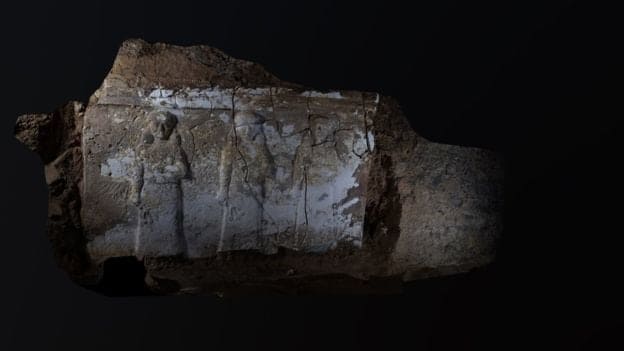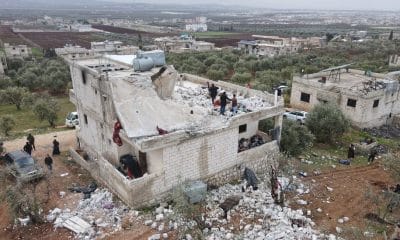Nigeria News
3,000-year-old Palace Discovered Beneath A Mosque Destroyed By The Islamic State

The extremist group calling itself the Islamic State in July 2014 bombed a shrine in Iraq. The temple of Nabi Yunus was located on a hill in the city of Mosul, which was for centuries a place of devotion.
During the Christian period, a monastery was built on the hill which for more than 600 years has become a Muslim shrine dedicated to the prophet Jonah.
By destroying it, militants of the Islamic State claimed that Nabi Yunus was no longer a place of prayer, but of heresy.
Images of the explosion swirled the world. The message was clear: no sacred site, even venerated, was safe from the radical interpretation of the Koran of the extremist group.
But the destruction of Nabi Yunus did not end, by far, with the history of the mountain. On the contrary, fascinating questions arose about what lay beneath the ruins of the mosque.
Unresolved mysteries
In the spring of 2018, the BBC’s Arabic service sent a team to explore the network of cold and dusty tunnels found inside the hill.
They took high resolution photos of the findings using a technique called photogrammetry and attempted to unravel mysteries that remained unanswered after the destruction of the sanctuary.

Many Muslims believe that the prophet Jonah’s remains are buried on the hill of Nabi Yunus, near the ancient city of Nineveh
In Arabic, Nabi Yunus refers to the prophet Jonah. Many Muslims believe their remains are buried there.
“Nabi Yunus has always been one of our most important religious and cultural sites,” explains Ali Y Al-Juboori, director of Assyrian Studies at Mosul University.
Undoing
On July 24, 2014, militants from the Islamic State ordered the faithful to withdraw and place explosives on the inner and outer walls of the mosque. Residents of the area were instructed to walk away and stay at least 500 meters from the temple.
The explosion reduced the mosque to rubble, and the Islamic state expelled the Christians from the city. For the first time in history, there was an attempt to turn Mosul into a city of unique religion.
The action was part of a wave of destruction of sacred places promoted by the extremist group.
At the Nergal Gate, located in the ancient city of Nineveh (within present-day Mosul), the combatants disfigured a statue of lamassu, a mythical creature guarding the entrance to Assyrian palaces. And they blew the door.

The militants of the Islamic State disfigured a statue of lamassu, a mythical creature that protects the entrance of Assyrian palaces
The Islamic State justified the destruction of Nabi Yunus by attacking the legitimacy of the sanctuary.
“It was a tomb for Christian popes,” an extremist told the BBC. “It is forbidden to build a mosque in a false shrine.”
In fact, scholarly research points out that Jonah was not buried there. It is believed that the bones attributed to him belonged probably to a Christian patriarch named Henanisho.
Buried palace
Under the ruins of Nabi Yunus there is a palace which was used both as a residence for the Assyrian kings, and as a base for their army. The structure, which dates back at least to the 7th century BC, is more than 2,700 years old.
When eastern Mosul freed itself from the rule of the Islamic state in January 2017, archaeologists found something peculiar under the rubble of the mosque: it had far more tunnels than had been documented before.
In fact, more than 50 new tunnels were discovered, some short and some more than 20 meters long.
Peter A. Miglus, a professor at the University of Heidelberg in Germany, who conducted a preliminary study on the tunnels, explained that the ground beneath the mosque was so full of holes that it looked like Swiss cheese.

The lamassu has the body of a bull, the wings of an eagle and the head of a man
Most of the tunnels appear to have been excavated with picks, but there are also traces suggesting the use of a small excavator. The largest tunnel is about 3.5 meters high, and the smallest does not reach more than one meter.
Initial reports suggested that it was the militants of the Islamic State who had dug the new tunnels.
But residents of eastern Mosul told the BBC that they hired locals to dig.
They wanted to plunder the Assyrian artifacts that were inside the temple. It is believed that the sale of antiques was the second source of income of the extremist group after oil.
The hill was plundered with care, probably to keep the discoveries intact. However, it seems that some findings were too great for the militants of the Islamic State to take.
Possibly the larger objects, some of them pinned to the walls, could not be removed without threatening the integrity of the tunnel structure.
Three women
When BBC journalists entered the dark tunnels of Mount Nabi Yunus in March 2018, many of the archaeologists’ findings were still there.
The most surprising finding was low-relief carvings on the walls that illustrated a row of women – a finding that raises more questions than answers.
Paul Collins of the Ashmolean Museum of Art and Archeology at the University of Oxford in the UK believes that these images are unprecedented.
It is very rare to find female figures on this scale. Women, on the rare occasions when they were immortalized, were often portrayed as prisoners of war or on a much smaller scale than the reliefs, which beat at the waist.

One of the walls of the tunnels was carved with bas-reliefs depicting a row of women
What intrigues experts in Assyrian art is that these women, instead of being represented in profile, as was customary in Assyrian sculpture, are in the front.
Although some scholars believe that repeated and identical drawings indicate that female figures are goddesses, Gansell takes another view.
According to him, the absence of horns or a special crown, symbols that used to be used to identify deities in Assyrian art, suggests that they could be representations of mere mortals.
Gansell believes that women can symbolize members of royalty or high society who brought offerings to a god, possibly during a ritual.
Nabi Yunus, who is the author of the book, said: “It is a unique insight into the role of women in Assyrian society and religion.
Lamassu
Along with the low-reliefs of the women, lamassus engravings were also found in the tunnels.
Statues of the mythical creature were built at the entrance to the Assyrian palaces to intimidate the enemies and ward off the demonic spirits.
In the Akkadian language, lamassu means “protective spirit”. They have the body of a bull, the wings of an eagle, and the head of a man.
The lamassus found in the tunnels are further evidence that the ruins were once at one time a holy place.
It is evidence of how Nabi Yunus’s story is kept alive despite the attempt to destroy it.







![Again, Bandits Kill Five Nigerian Police Inspectors In Zamfara - [See Their Identities]](https://www.naijanews.com/wp-content/uploads/2020/12/ISIS-Boko-Haram-Terrorists-400x240.jpg)
![Again, Bandits Kill Five Nigerian Police Inspectors In Zamfara - [See Their Identities]](https://www.naijanews.com/wp-content/uploads/2020/12/ISIS-Boko-Haram-Terrorists-80x80.jpg)



